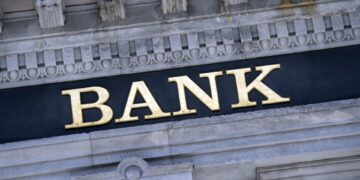This story originally appeared in the Winter 2021 issue of The Voice. Read the full digital issue here.
Let’s get this out of the way: Banking isn’t sexy. It’s harder to talk about than solar power. It’s harder to sell than responsibly sourced down. It’s boring. But think of it like a good mob front: The more mundane the exterior, the more it has to hide. Last year, the Conservation Alliance made waves by leaving Bank of America after a two-decade financial relationship. Four years before that, the Sierra Club Foundation jumped ship on Union Bank for Amalgamated Bank, a little-known institution with limited services. Each of these switches was a cutting-edge, revolutionary statement—and a lot harder to pull off than you might think.
What’s the big deal?
For one, it’s a huge pain to switch banks. There are papers to sign, meetings to attend, payroll and bills to move over. Companies just don’t do it. So if you’re a big firm, gathering up your things and walking out is a surefire way to send a message that you’re not happy. And the aforementioned nonprofits were not happy.
After all, Bank of America was providing more than $48 billion per year in financing to fossil fuel companies. A chunk of that money belonged to the Conservation Alliance, which had spent two decades working to prevent Arctic drilling. When the nonprofit asked Bank of America to pledge not to invest in Arctic National Wildlife Refuge pipeline projects, it refused the request. Like we said: not happy.
The secret life of money
Here’s how bank investing works: You deposit money in your account. You start making interest, which is a fraction of the interest your bank is making on your money. That’s their business model: Banks keep your savings safe, and in return, they get to invest them in whatever they want—whatever they feel will be most lucrative.
Right now, in this global economy, that’s fossil fuels. It’s fast fashion. It’s deforestation operations and palm oil plantations. It’s Big Tobacco. It’s single-use plastics. It’s all the things that the outdoor industry has rejected—at least, in theory.
“We didn’t want our money to be leveraged to finance the very things we’re fighting against,” says Dan Chu, executive director of the Sierra Club Foundation, which pulled its $30 million in assets from Union Bank in 2016. At the time, Union had just merged with Mitsubishi UFJ Financial Group, which was funding the company behind the Keystone XL Pipeline. The Sierra Club Foundation could keep trying to stop the pipeline, but banking with Union would effectively undo every effort. So, it switched to Amalgamated Bank, which has high sustainability and social-justice investing standards.
Likewise, the Conservation Alliance ultimately moved to Bank of the West, a 1% for the Planet member that has begun divesting from fossil fuels and other environmentally harmful industries.
These switches are great success stories, but in the outdoor industry, they’re rarities.
Where the outdoor industry banks
In reporting this story, The Voice asked 15 brands where they bank. Brands with Bank of the West, Amalgamated, or credit unions were happy to reply. A few others, like Snowsports Industries America and Patagonia, revealed that they were shopping around for a new institution, but declined to mention their current banking partners.
REI did point to its relationship with U.S. Bank, which hosts the REI MasterCard program. And VF Corp. acknowledged working with “many different banks,” including Bank of New York Mellon. Every other brand declined to comment.
A likely truth is that most outdoor companies bank with the biggest in the US: JP Morgan Chase, Bank of America, Citi, Wells Fargo, Goldman Sachs, Morgan Stanley, and U.S. Bank (see sidebar).
“The banking system is hard,” says Howard Fischer. Fischer is the CEO of hedge fund Basso Capital Management and co-founder of Gratitude Railroad, an investment firm dedicated to impact investing. “When you’re a company with hundreds of billions of dollars flowing in and out of the coffers, you need a pretty sophisticated bank. With that much money involved, it’s hard not to deal with mainstream banks.” But the status quo isn’t pretty.
“For a big bank that’s a large financier of the fossil fuel industry, five percent of their portfolio might be in fossil fuels,” says Ben Stuart, head of growth and transformation and chief marketing officer at Bank of the West. “Five percent is a big number.”
The carbon footprint fallacy
There’s another, more abstract problem with dragging your feet about a bank switch: The longer banks remain comfortable, the longer the power structure remains intact, says Auden Schendler, senior VP of sustainability at Aspen Skiing Company. That means big banks keep funding Big Oil, Big Oil keeps funding lobbyists, lobbyists keep controlling policy, and things like carbon pricing—which Fischer sees as essential for real climate impact—never become law.
Meanwhile, outdoorspeople remain hyperfocused on small, personal steps like biking to work and recycling—which, says Schendler, is exactly what extractive industries want.
“The fossil fuel industry wants a ski resort to aggressively reduce its carbon footprint,” Schendler says. “It doesn’t impact them at all, and the power structure stays in place. Plus, it means the ski resort is taking responsibility for its own carbon footprint when it’s really the fossil fuel company that’s to blame.” Unless coupled with some kind of real power play, campaigns that encourage recycling and biking to work, Schendler claims, are just distractions.
Conversely, when a big firm changes its bank, that sends a strong financial message—the only kind of message that can really push at power, Fischer says. The switch also sends a message to customers.
An end to greenwashing
As hard as it is, dumping your bank might be the easiest way to show your brand cares about the environment, says Chu. For one thing, it’s cut and dried. Ask brands about their DEI efforts or commitment to sustainability, and it’s easy to retreat into marketing jargon and greenwashing. But ask them where they bank? They’re either funding fossil fuel extraction, or they’re not. Responsible banking is the outdoor industry’s chance to get real—with itself and with its customers—about its commitment to the environment.
In recent years, the industry has focused largely on greening up its supply chains. Robinson says brands can look at financiers and insurance companies as part of those supply chains—and subject them to just as much scrutiny as shipping or manufacturing partners.
Plus, with increased awareness around responsible banking, making the switch can give your brand a competitive edge.
Ryan Hartegan, founder of Golden State Guiding in California, moved his company to Bank of the West in the summer of 2020.
“I just wanted to do it on a moral level,” he says. “I didn’t want my money, whether it was a drop in the bucket or not, supporting the fossil fuel industry anymore.” What he didn’t expect: the wave of support and attention his brand got after announcing the switch.
“From a marketing standpoint, it was really good for the business. It gave us something else to talk about to show that we’re more than just a guide service,” Hartegan says.
Harsh realities
For the Sierra Club Foundation, the whole process of switching banks took around 18 months. For the Conservation Alliance, the process is ongoing. But onerous paperwork isn’t the only hurdle.
The responsible-banking industry is painfully young. Patagonia says it’s “actively researching” new banks, but few are big enough to handle a complex global business, CEO Ryan Gellert told SNEWS.
“There are divestment activities happening at banks, but I would say there are no green banks of scale,” he says. “What we need is global banks to really embrace a different way of doing things…The harsh reality is I think none of them are all that progressive.”
One issue is that awareness surrounding clean finance is fairly new. Another barrier is that fossil fuels, Big Agriculture, and other “dirty” industries are so lucrative that many banks aren’t willing to kick them curbside, even under an avalanche of public pressure.
Take Bank of America, for example. Even after a dozen global
banks bowed to public outrage and pledged not to fund Arctic Refuge drilling, Bank of America stayed its course for nearly a year, remaining the only major US bank to do so. It wasn’t until November 2020—about a month after Conservation Alliance left—that it formally pledged not to provide project financing for Arctic Refuge oil.
“From a bank’s perspective, it comes down to how much revenue you generate from these activities that harm the planet,” says Bank of the West’s Stuart. “You have to get to the point where the revenue that’s leaving starts to outweigh the revenue the bank is gaining.”
The tipping point
To save the planet, banks need to change. For banks to change, it’s going to take a lot: public pressure, bad press, big defections, and a landslide of lost customers, says Fischer. Fortunately, you don’t have to switch your entire operation to start rocking the boat.
If a responsible bank doesn’t offer international wiring or other services you need, it’s probably because they’re not big enough yet, explains Chu. You can move the bulk of your assets to a responsible investing account without completely giving up your old bank. That still sends a message, and it kicks off positive impacts. Relocating your cash not only shrinks the pool of money that dirty industries can pull from; it also helps responsible institutions grow big enough to offer more services and attract other high-profile clients, he says.
If you can start the process, start. And be vocal about it.
“If your bank is doing something you don’t like, tell them,” Robinson says. “Banks need to know that consumers are paying attention.”
What’s the damage?
Collectively, the 11 outdoor behemoths we investigated (see below) had $5,885,159,000 in cash, cash equivalents, and short-term investments according to Q3 2020 SEC reports. If 5 percent of each portfolio goes to extractive industries, that’s $294,257,950 funding extraction annually.











